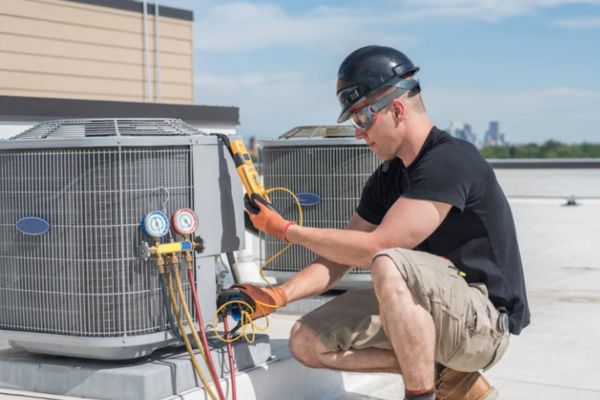Modern radiators are essential components of heating systems. They are primarily designed to efficiently transfer heat from a central source to individual rooms or spaces within a building. They operate on the principles of conduction and convection, utilizing hot water or steam to provide warmth. Let’s explore how it works.

Basic Principles of its Operation
1. Heating the Fluid
- Water or steam is heated in a boiler or a central heating system. In hot water systems, the water is heated to a high temperature. In steam systems, water is boiled to create steam.
2. Fluid Circulation
- The hot water or steam is then pumped or naturally travels through a series of pipes connected to the radiator.
- Inlet valves allow the hot fluid to enter the radiator.
3. Heat Transfer
- As the hot fluid flows through the radiator’s tubes or channels, it transfers its heat to the metal surface of the radiator.
- Fins or ribs attached to the radiator increase the surface area, allowing the air in the room to absorb more heat.
4. Radiating Heat
- The radiator releases heat into the room by warming the air around it. This happens through both radiation (direct heat transfer) and convection (air movement around the heated radiator).
- The warmer air rises, and cooler air replaces it, creating a natural circulation that evenly heats the room.
5. Returning the Fluid
- In a hot water radiator, the cooled water travels through an outlet pipe and returns to the boiler to be reheated.
- In a steam radiator, the steam cools and condenses back into water, which flows back to the boiler through a return pipe.
6. Thermostatic Control
- Many modern radiators feature valves that regulate the flow of hot water or steam, allowing users to control the room temperature.
- Smart thermostats and TRVs (Thermostatic Radiator Valves) can further enhance efficiency by adjusting heat output based on room temperature or user preferences.
In summary, radiators heat a room by circulating hot fluid through metal coils or panels, transferring heat to the air, which warms the space.
Regular maintenance, such as bleeding air from the radiator and checking the boiler, ensures the system operates efficiently.
Essential Components of Radiators
The design of radiators is more than just functional—it’s optimized for maximum efficiency. Here’s a closer look at the essential components that make these systems so effective.
- Core: The core is the backbone of the radiator, where hot fluid circulates through an intricate network of tubes. These tubes are designed to efficiently transfer heat from the fluid to the surrounding air, ensuring your space is heated effectively.
- Fins or Ribs: Modern radiators incorporate fins or ribs to boost performance. These components increase the surface area of the radiator, allowing more air to come into contact with the heated surface, which enhances heat dissipation.
- Inlet and Outlet Ports: These vital ports allow heated fluid to enter and leave the radiator, facilitating the constant flow of hot fluid. This keeps the system operating smoothly and consistently distributes heat throughout the room.
- Valves: Valves are the control points for managing the flow of fluid in and out of the radiator. With these, you can easily regulate room temperatures, ensuring each space stays comfortably warm or cool, depending on your needs.
How Does Radiator Transfer Heat?
When you look at a typical radiator, you’ll notice its surface is full of folds or fins, often made from metals like cast iron. These folds aren’t just for aesthetics—they increase the radiator’s surface area. By expanding the surface area, the radiator can come into contact with more air, allowing for more efficient heat transfer throughout the room.
Does Radiator Circulate Air?
Unlike other heating systems, radiators don’t need blowers to circulate air. As the air around the radiator heats up, it naturally rises, allowing cooler air to move in and be warmed. This process creates a continuous circulation of air, forming a convection current that gradually warms the entire room without the need for mechanical assistance.
Why Radiator Balancing is Important
Unlike forced air systems, where balance is inherently built into the design, radiators require manual adjustment to ensure they operate efficiently. Achieving the right heat output for all radiators in your home involves regulating the flow of hot water through each radiator. The slower the water moves, the more heat the radiator emits. Conversely, faster water flow results in less heat being released.
If the difference exceeds 10 degrees Celsius, the water moves too slowly, leading to heat loss. In this case, adjusting the valve to increase water flow should help. On the other hand, if the temperature difference is too small, reducing the flow will improve the balance.
The thermostatic radiator valve (TRV) is essential in maintaining radiator efficiency. It features a sensor that adjusts the water flow based on room temperature, ensuring optimal comfort. Here’s a breakdown of its components:
- Thermostatic Head: Detects the room’s temperature.
- Heat-Resistant Molding: Protects the valve from heat damage.
- TRV Insert: Controls the flow of water through the radiator.
- Connection Points: Links the valve to the radiator and the heating system.
Balancing your heating system ensures an even temperature throughout your home, preventing some rooms from being too hot while others remain cold. Properly balancing your radiators will enhance comfort, optimize energy efficiency, and reduce the wear on your heating system.
Regular maintenance is key. Keeping your radiators in top working condition and serviced annually can save you from costly repairs and ensure your home remains warm for years to come. The investment in regular upkeep pays off by extending the life of your system.
Radiators are an essential part of modern heating systems. They efficiently distribute warmth through natural convection and conduction. With design elements like fins to enhance heat transfer and thermostatic controls for temperature regulation, they provide practical and energy-efficient heating.
Regular maintenance ensures optimal performance and modern upgrades like TRVs and smart thermostats can further boost efficiency. Whether using hot water, steam, or electricity, radiators remain reliable for maintaining comfortable indoor environments.



